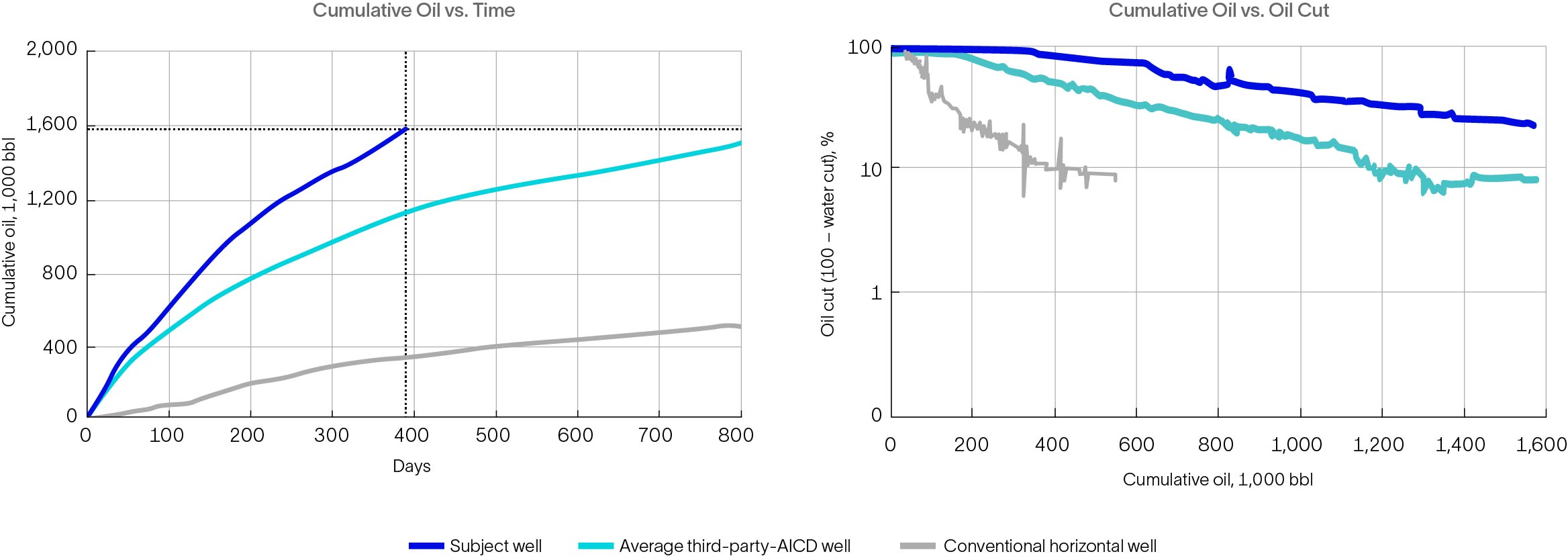Reservoirs with early gas or water breakthrough risk
Optimized cyclonic autonomous ICD completion boosts production and lowers emissions
In a heavy oil field with a strong water drive, a comprehensive approach to well construction and completion design—incorporating use of cyclonic autonomous inflow control devices (AICDs) and chemical tracers—improved oil production by 41%. It also reduced the amount of produced water, lowering energy consumption related to water disposal by 7 GW.h in approximately 1 year and decreasing the carbon intensity per barrel of oil equivalent.
Energy consumption reduction
Emissions reduction
Reducing produced water was key to field economics and the environment
An operator in Peru wants to increase oil production and recovery from its field by monitoring and controlling zonal production. At the same time, disposal of produced water is a major concern. The heavy oil reservoir comprises an unconsolidated sandstone formation with an active aquifer. An internal report found that produced water disposal via injection into the subsurface accounted for approximately half the power requirements for field operations. Because of the remote location, most of the energy demand is satisfied by onsite generators using the heavy oil. Minimizing the cost and environmental impact of produced water management are important objectives.
Holistic approach to well construction and completion plus advanced technologies increased oil and reduced water output
For this compartmentalized reservoir, SLB recommended an integrated approach and workflow that included
- well placement using MWD and LWD
- use of cyclonic AICDs, formation evaluation, and advanced well modeling to optimize the completion design and delay water breakthrough
- chemical tracers embedded in the sand screens to monitor oil and water production from each compartment without need for well intervention
- analysis of tracer samples from the producing well to determine flow contributions from each compartment and AICD performance along the wellbore.
A candidate well was identified, and a preliminary completion design was created to address reservoir heterogeneity and achieve optimal inflow. The number of compartments and AICDs required in each compartment were determined along a 1,000-m-long [3,280-ft-long] horizontal well section.
High-resolution laterolog resistivity imaging enabled geosteering within the target zone while minimizing tortuosity, which could have hindered completion equipment installation. After the base completion design was updated with the LWD data, the advanced completion optimization module in Petrel™ subsurface software was used to refine completion architecture, including compartment lengths and the number of AICD nozzles per screen joint. The result was reviewed and further changes implemented based on inputs from the geology, reservoir, and production teams.
Once the well was brought online, no water production was observed for the initial few months. When water breakthrough eventually occurred—significantly later compared with offset wells—tracer analysis was used to identify the source compartments and refine understanding of the vertical heterogeneities at a structural level.
Over a period of approximately 1 year, cumulative oil recovery from the subject well was 41% higher than the average from eight horizontal offset wells with third-party AICD screens, and nearly 380% higher compared with the single conventional horizontal offset well. During the same interval, water production from the optimized well was about 2 million bbl less compared with the average offset well with AICDs. As a result, the power required to inject excess water into disposal wells reduced by approximately 7 GW.h, equivalent to 4,400 bbl of fuel. By decreasing water production, the integrated optimized completion eliminated about 1,863 metric tons of CO2e emissions during the year. Based on this success, the operator has adopted the workflow for additional wells in the field.

